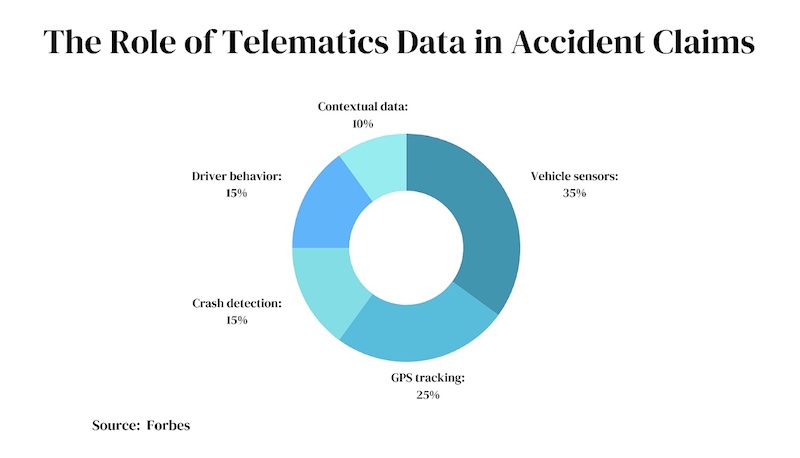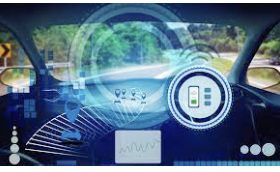The use of telematics data in car accident claims is on the rise. Telematics refers to technology that collects and transmits data from vehicles. Studies have shown that telematics has a positive impact on fleet accidents and vehicle management, enabling companies to reduce fleet incidents by 80%, accident claim costs by 50%, and the overall number of claims by up to 30%.
In recent years, telematics has become an invaluable tool for insurance companies and lawyers investigating fault after a collision. With advanced telematics technology, detailed vehicle data can be collected, including:
? Vehicle speed before and at the time of impact
? Braking patterns
? Seatbelt usage
? Acceleration or deceleration
? Steering wheel position
? Activation of driver assistance systems
This objective data can prove invaluable in determining which driver was at fault after a crash. Rather than relying on witness testimony or subjective assessments, telematics provides concrete evidence for insurance claims and legal proceedings.
In recent years, telematics has become an invaluable tool for insurance companies and lawyers investigating fault after a collision. With advanced telematics technology, detailed vehicle data can be collected, including:
? Vehicle speed before and at the time of impact
? Braking patterns
? Seatbelt usage
? Acceleration or deceleration
? Steering wheel position
? Activation of driver assistance systems
This objective data can prove invaluable in determining which driver was at fault after a crash. Rather than relying on witness testimony or subjective assessments, telematics provides concrete evidence for insurance claims and legal proceedings.
The Role of Telematics Data in Accident Claims
In the past few years, a technology called “telematics” has become really important for insurance companies and lawyers when they’re trying to figure out who’s at fault in a car accident.
With more and more cars becoming smart and connected to the internet (IoT), telematics is being used a lot in the process of dealing with car accident claims.
The use of telematics data in car accident claims is on the rise. Telematics refers to technology that collects and transmits data from vehicles. For car accident lawyers like the experienced Denver car accident lawyers at telematics offers an objective source of evidence to establish liability.
Telematics is a fancy word for technology that gathers information from cars and sends it wirelessly to insurance companies, car makers, and other platforms. This information helps them understand how a car was driven just before, during, and after a crash.
Specifically, advanced telematics systems can capture:
? Vehicle speed, acceleration, and braking patterns through pedal pressure sensors
? Seatbelt usage via buckle sensors
? Steering wheel position and erratic maneuvers using gyroscopes
? External impacts detected by crash sensors
? Location and routes driven through GPS tracking
? Contextual data like weather conditions and road terrain
By providing a second-by-second account of driver inputs and vehicle reactions, telematics offers an objective view of accident dynamics. This can substantiate or refute driver testimony and witness accounts when establishing liability.
For instance, sudden deceleration combined with swerving recorded by telematics may indicate a distracted driver failed to stop in time. Excessive speed revealed in engine telemetry could prove a driver lost control while over the speed limit.
As this technology advances, even more driver assist features can be monitored, like lane centering corrections, automatic braking activation, and adaptive cruise control adjustments. This provides a forensic analysis of driver and vehicle performance before a crash occurs.
Overall, telematics delivers data-driven evidence to determine fault when liability for an accident is disputed. This technology is transforming insurance claim investigations and enabling fairer outcomes from legal proceedings. Detailed telematics can definitively establish whether driver negligence or other factors caused a collision.

This data provides insights into how a vehicle was driven and can help determine fault in an accident.
Case Studies: Telematics Data in Action
To understand the real-world impact of telematics, let’s look at some examples of how this data has been used to resolve liability disputes:
Case Study: DWF successfully deployed telematics evidence for the first time in a remote Trial, resolving a liability dispute following a high-speed motorway accident. The telematics data was used to prove that the defendant had been driving over the speed limit when he lost control of his vehicle. This evidence was central to the claimant’s success in their case.
Case Study: A dispute between two trucking companies regarding who was at fault in a rear-end collision was resolved using telematics records. The data showed that truck A had been braking unexpectedly, while truck B was maintaining a safe following distance at a steady speed. This allowed truck B’s insurance claim to succeed.
These cases demonstrate the power of telematics in providing definitive insights into driving behavior and accident dynamics. The data offers unbiased clarity when determining fault, leading to fairer outcomes.
The Legal Perspective: Insights From Lawyers
To understand the legal viewpoint on telematics data, we spoke with personal injury attorneys about their experiences using this evidence in court cases.
Mark Davis, a partner at Stewarts Law, gave his perspective: “In-vehicle telematics provides an impartial witness to how an accident happened. As long as the proper disclosure is given on data reliability, lawyers are increasingly using this information to piece together liability.”
However, Davis cautioned that some limitations remain: “Telematics isn’t a silver bullet. You still need to combine it with witness testimony and accident reconstruction expertise. But it provides an extra layer of factual evidence.”
Jennifer Cartwright, a personal injury lawyer based in Denver, CO shared a similar outlook: “I’ve had several cases where telematics gave clear indications of excessive speed or distracted driving patterns. This data carries significant weight in negotiations and court proceedings.”
Yet Cartwright noted the need for legal guidelines: “As the capabilities of telematics improve, we need to ensure appropriate transparency and discovery standards are in place.”
Overall, lawyers see telematics as a useful source of evidence, while recognizing the need to apply it carefully. As case law develops, legal standards around the use of telematics data will become more defined.
The Future of Telematics Data in Accident Claims
Looking into the future, the role of telematics in car accident claims is going to get much bigger. This is because more and more cars are becoming smart and connected to the internet (IoT), and car makers are adding better ways to record data.
Here are some things we expect to happen:
? By 2025, almost all cars will come with a built-in internet connection.
? In 2024, super-fast 5G networks will send telematics data in real-time.
? Self-driving cars will instantly share data about any accidents they’re involved in.
As all this connection grows, insurance companies will learn a lot more about how people drive and how risky they are. For people who handle insurance claims and lawyers, having detailed telematics records for all the cars in an accident will become normal. Instead of arguing about who’s to blame, they’ll focus on understanding all this data.
We’ll also use smart computer programs and AI to process all this data and figure out what happened in accidents and who’s at fault. But human experts will still be important, especially when it comes to things like weather and car defects.
FAQs
Can telematics data be used to deny an accident claim?
Insurers may utilize driving behavior identified via telematics to deny a claim in certain scenarios. For example, if the data showed extremely reckless driving, speeding, or clear disregard of traffic laws, the insurer could argue these factors caused the accident. However, the telematics would need to definitively prove the policyholder’s actions directly led to the collision.
How accurate is telematics data in determining fault in an accident?
The accuracy of telematics is improving constantly but can still have limitations. GPS coordinates may have margins of error, while crash sensors can sometimes activate from non-collision impacts. However, telematics accuracy is generally reliable when used alongside other evidence sources. Continued advances in the technology will further enhance precision.
What is the legal standpoint on using telematics data in court cases?
The admissibility of telematics data as evidence varies between jurisdictions. Broadly, as long as the data’s reliability can be validated, and proper discovery procedures are followed, telematics is generally deemed admissible. However, specific standards differ, and courts still have discretion on whether to allow it. Clear case law precedents will continue developing as the use of telematics grows.
Final Thoughts
Telematics technology is transforming investigations into fault after vehicle collisions. By providing detailed insights into driver behavior and accident dynamics, telematics offers objective evidence to resolve liability disputes fairly and efficiently.
While some limitations around accuracy and admissibility remain, telematics is gaining rapid acceptance in claims processes and legal proceedings. As vehicles become smarter and more connected, the use of telematics data will soon become routine in determining blame for car accidents.




